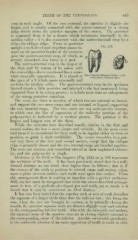Page 435 - My FlipBook
P. 435
TEETH OF THE VERTEBRATA. 445
cusp at each angle. Of the two external, the anterior is slightly the
larger, and is usually connected with the antero-internal by a strong
ridge which skirts the anterior margins of the crown. The posterior
is separated from it by a fissure which terminates internally in the
it is also connected with the antero-internal cusp by a
median valley ;
1 11-
rido;e, the oblique ridge. From its posterior
'''^^
• 11 1 • Fif ""
margin a well-developed cmgulum passes in-
ward on the posterior border of the crown to
join the postero-internal cusp, of which, as
already remarked, this latter is a part.
The antero-internal cusp is the largest of
the four, and by reason of its union with
the cross-ridges above mentioned has a some-
what crescentic appearance. It is placed at
^""''eS';nd""™S°vie\v."^^
the apex of a V which opens externally and
encloses the median valley. The postero-internal cusp in the sjiecimen
figured stands a little posterior and internal to the last mentioned, being
separated from it by a deep groove it is little more than an enlargement
;
of the strong posterior (unguium.
The roots are three in number, of which two are external or buccal,
and support the two outer cusps, and one internal or lingual, supporting
the two internal cusps. The two outer are not unfrequently connate,
in which case the line of separation of the radicular portions of the
j)ulp-cavities is indicated by a vertical groove. The palatine is the
largest and longest root of the three.
While the structure here described usually obtains in the first and
second molars, the last is more simple and variable. In the more civil-
ized races it is exceptional for these teeth to be regular either in form or
position, so great is their variability. The crown resembles in a gen-
eral way those of tlie first and second molars, except that the oblique
ridge is generally absent and the two internal cusps are blended together.
The roots are connate and somewhat curved at their implanted extrem-
ity, and the pulp-cavity is single.
Occlusion of the Teeth.—Tlie diagram (Fig. 224) on p. 446 represents
the occlusion of the teeth. It has been previously stated that in a well-
formed denture no one tooth rises higher than its fellows ; that is, if
the crowns of the teeth in position be turned, cusps and cutting edges,
upon a plain or even surface, each tooth rests upon this surface. From
this arrangement there is nothing to interfere with a perfect occlusion.
Still, the fact must be recognized that while the above-described arrange-
ment is true of a perfectly-developed jaw and teeth, yet so rarelv is it
found that it may be considered an ideal denture.
It has also been stated that the superior arch or row of teeth describes
the segment of a larger circle than does the inferior row ; this being the
case, when the two are brought in contact, as in normally closing the
mouth, the anterior superior teeth are thrown slightly over and anterior
to the corresponding inferior teeth. Also with the bicuspids and molars,
the external cusps of the superior ones are in closing slightlv external to
the corresponding cusps of the inferior. Another serviceable peculiarity
is the noticeable absence of an exact opposition of tooth to tooth in clos-


